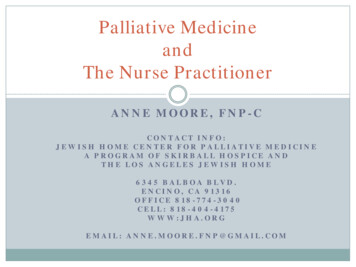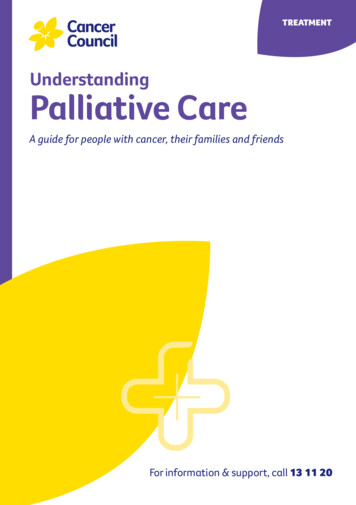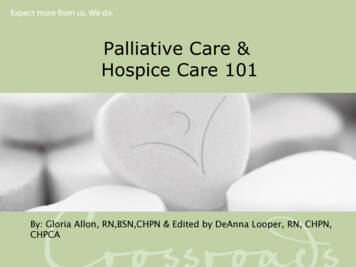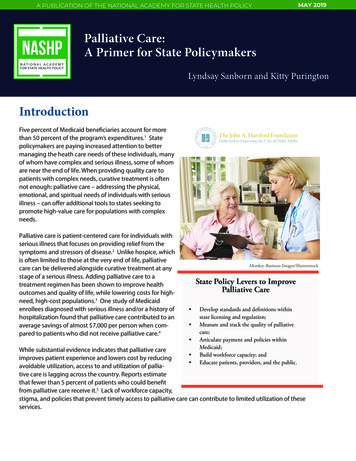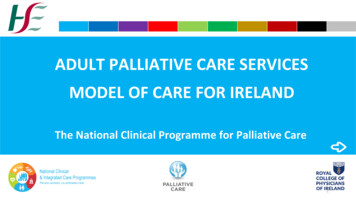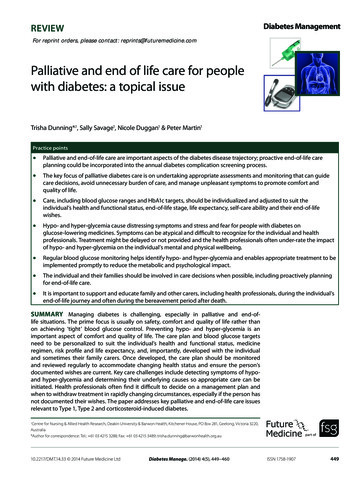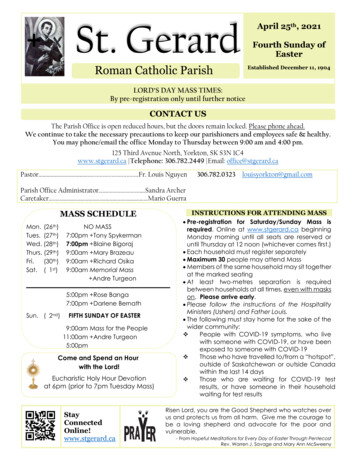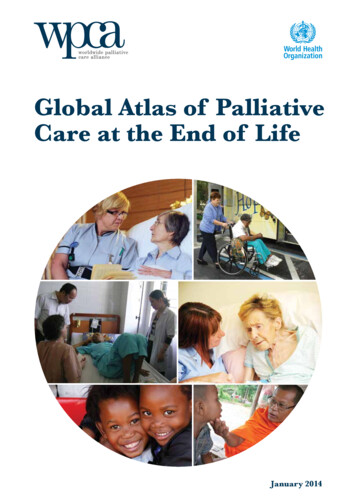
Transcription
ng.comSymbiosisResearch ArticlePalliative Medicine & Care: Open AccessOpen AccessRevisiting Retrospective Chart Review: An Evaluation ofNursing Home Palliative and End-of-Life Care ResearchAbigail Wickson-Griffiths1, Sharon Kaasalainen1*, Jenny Ploeg1 and Carrie McAiney2School of Nursing, McMaster University Hamilton, Ontario, CanadaDepartment of Psychiatry & Behavioural Neurosciences and Seniors Mental Health Service, St. Joseph’s Healthcare Hamilton, Ontario, Canada12Received: February 04, 2014; Accepted: February 04, 2014; Published: May 03, 2014*Corresponding author: Sharon Kaasalainen, McMaster University, 1280 Main Street West, Health Sciences Centre -3N25F, Hamilton, ON, L8S 4K1,Canada, Tel: 905-525-9140, ext. 22291; Email: kaasal@mcmaster.caAbstractObjective: Retrospective chart review is a popular method ofdata collection in palliative and end-of-life care research. This paperprovides an evaluation of the reliability and validity of this methodin the long-term care home-based palliative and end-of-life careresearch literature.Methods: Eight criteria were used to critically evaluate thereliability and validity of the retrospective chart review datacollection methods in (n 13) studies meeting inclusion criteria.Results: Only two criteria: defining both the important variables,and inclusion and exclusion criteria, which largely demonstratevalidity, were consistently well described in this body of literature.However, the criteria used to mainly demonstrate the reliability ofthe method, especially data abstractors’ monitoring and blinding, andtesting for inter-rater reliability, were not well addressed.Conclusion: Overall, there was a limited description of themeasures used for evaluating the validity, and especially thereliability of the retrospective chart review method included inthe long-term care home-based, palliative care literature. As such,readers should proceed with caution when using this source ofliterature to inform palliative care research and practice, andcarefully consider the inclusion of the measures of validity andreliability. Additionally, palliative care researchers should carefullyconsider the source of data as well as an instructional guideline whenengaging in retrospective chart reviews.Keywords: Retrospective chart review; Long-term care homes;Palliative careIntroductionAs palliative care becomes a more mainstream approach infacilitating end-of-life or terminal care in long-term care (LTC)homes [1], researchers have sought to describe and evaluatethis method of care. In a variety of health care fields, includingpalliative care, a popular method of data collection is retrospectivechart review [2,3]. Using the retrospective chart review methodallows researchers to examine, record and understand pastclinical events documented in persons’ medical charts [4,5].However, despite retrospective chart review’s touted feasibility,issues with the reliability and validity of this data collectionSymbiosis Group*Corresponding author email: kaasal@mcmaster.camethod have been identified, due to both the limitations of thechart itself and the guidance in using this method provided inthe literature [4,6,7]. It is important to examine the reliabilityand validity of retrospective chart review used in palliative careresearch, as the findings of such studies employing this methodmay ultimately shape how end-of-life care is provided in LTChomes. Therefore, the purpose of this paper is to review andevaluate the reliability and validity of the retrospective chartreview method in LTC home-based palliative and end-of-life careresearch.Retrospective Chart ReviewIn order to appreciate the use of retrospective chart reviewin health care research, it is essential to define it and understandboth the advantages as well as areas for caution when using thisdata collection method. Retrospective chart review is a specifictype of data collection method used in archival research andcan be understood in two parts [5]. First, the term retrospectivemeans to look back in time, and in this case, at clinical events[4]. Second, the information in the medical chart is used as thesource of data. This data collection method is commonly usedin studies with retrospective designs, where research questionscannot be answered prospectively [4]. It is especially appropriatein evaluating approaches to palliative and end-of-life care, asneither the dying person nor their family member is burdenedwith actively participating in the research process at or near thetime of death.Although study designs and data collection methods should bebased on the most rigorous way of answering research questions[8], several advantages of employing the retrospective chart reviewmethod encourage its use. It has been touted as a “quick and dirty”option because the clinical data already exist and just has to beabstracted from the medical charts [2,4]. Another advantage ofretrospective chart review includes the relatively low cost whencompared to prospective trials [4,9]. In addition, medical charts aregenerally accessible to researchers, and can be a source of clinicalrichness and accuracy. Due to these advantages, retrospective chartreview may be suitable for pilot work in the LTC home setting, ifvalid and reliable methods are employed.
Revisiting Retrospective Chart Review: An Evaluation of Nursing Home Palliative andEnd-of-Life Care ResearchWhile it is recognized that chart reviews can be a convenientmethod of data collection, there are many complexities inretrieving relevant, high-quality information [10]. Importantly,authors have noted a lack of published well-establishedapproaches to retrospective chart review, which leaves thevalidity and reliability of the method in question [6,7,11]. Tounderstand how validity and reliability affect retrospectivechart reviews, it is first important to explain and define each.Validity describes the degree to which a tool, protocol or processaccurately represents the concept or topic it was designed tomeasure [12]. Reliability describes the degree that a tool, protocolor process will generate the same or similar results when it isused over time, with the assumption that what is being measuredremains unchanged [12].Several limitations of retrospective chart review have beennoted around the chart itself, as well as the process of abstractionthat threaten the overall validity and reliability of the method.Limitations of the medical chart itself in retrospective studies havebeen recognized including: inaccurate, incomplete or illegibledocumentation, as well as variance in the quality and locationof the information recorded by medical professionals [4,13,14].Many limitations of the chart review process have also beenrecognized and include: missing charts; lack of a clear procedurefor data abstraction and how to handle missing or incompletedata; lack of abstractor training or blinding to the study purpose;and inconsistency or mistakes in coding chart information[11,15]. Together, these limitations may negatively impact thevalidity, and especially, the reliability of the retrospective chartreview method, and any subsequent study findings.Chart Review in The Palliative Care ContextThe definitions of palliative care provided by the CanadianHospice Palliative Care Association [16] and the World HealthOrganization [17] include that it is an approach to care whichaims to enhance quality of living and dying for persons facing lifethreatening illness, through the relief of pain and suffering, andattention to physical, psychosocial and spiritual needs. For thepurposes of this paper, palliative care is considered an approachto caring for residents at the end of their life or facing a terminaldiagnosis. However, no definite time period has been determinedfor when the palliative approach to end-of-life or terminal care isappropriate [18].The need to improve palliative care for residents of LTC homeshave been recognized in combination with continuing efforts toadvance LTC home staff’s knowledge [19,20]. More high-qualitystudies are needed to test interventions to improve LTC homeprocesses and resident outcomes [19]. It is postulated that aretrospective chart review method may serve as an entry pointfor researchers and LTC home personnel to assess the qualityof current palliative care processes and outcomes. Pilot trialsusing this approach or accessing published studies that haveused retrospective chart reviews may lead to the development ofinterventions or implementation of quality assurance programsaimed at improving palliative and end-of-life care. Given thepossible threats to the reliability and validity of this method, itCopyright: 2014 Wickson-Griffiths et al.is important to examine the palliative care literature. Therefore,the following research question was explored, do palliative orend-of-life care studies, set in LTC homes, use reliable and validmethods when employing retrospective chart review as the soleapproach to data collection?DefinitionsThe following definitions will be applied throughout thispaper. A LTC home provides accessible 24-hour nursing care forpersons over 18 years of age [21]. References to nursing homes,long-term care geriatric institutions or facilities in the studiesare defined as a LTC home. Any references to a chart review isdefined as data collected from a chart review, chart audit, clinicalrecord review, medical record audit or medical record reviewprocesses, as reported in the literature. The chart itself maycontain past documented medical histories, clinical orders, testresults, and assessment and care notes, specific to an individualperson. The chart can be in either paper or electronic format, or acombination of both formats.MethodsSearch strategyIn order to search for relevant literature, a library consultanthelped to determine electronic databases and key search termsfor LTC homes, palliative and end-of-life care, retrospective,and chart reviews. See Table 1 for an example of the searchterms. The following electronic databases were searched andyielded the following results in January, 2014: Ageline (n 31),Excerpta Medica Database (EMBASE) (n 258), Cumulative Indexto Nursing and Allied Health Literature (CINAHL) (n 104), andMedline (n 179). No date restrictions were used in the searchbut the results were limited to the English language.Study selectionThree inclusion criteria were used to select the studies forevaluation. First, the study had to employ retrospective chartTable 1: Example of Search Terms.Group of Search TermsTermsHomes for the Agedlong-term carelong term care adj5 liv*long term care centre*Long-term care homelong term care facilit*long term care home*long term care residence*long term care resident*nursing home*palliative carePalliative careend-of-life careterminal carechart audit*chart review*medical audit*Retrospective chart reviewmedical record*medical record reviewretrospective designretrospective stud**Each grouping of search terms first combined using the OR command.The three groupings were then combined with the AND command.Citation: Wickson-Griffiths A, Kaasalainen S, Ploeg J, McAiney C (2014) Revisiting Retrospective Chart Review: An Evaluationof Nursing Home Palliative and End-of-Life Care Research. Palliat Med Care 1(2): 8. DOI: http://dx.doi.org/10.15226/23748362/1/2/00110Page 2 of 8
Revisiting Retrospective Chart Review: An Evaluation of Nursing Home Palliative andEnd-of-Life Care Researchreview as the main method of data collection. Second, the studydescription had to clearly indicate that the data were abstractedfrom LTC home residents’ charts. Therefore, studies that includeddata collection from multiple types of settings (e.g., hospice orhospital) were included, as long as at least one cohort of chartswas obtained from a LTC home setting. Also, the data had to beabstracted and analyzed from the persons’ charts, as opposedto being part of a secondary analysis. Finally, the study had tofocus on the provision of palliative or end-of-life care to residentsof LTC homes. As described above, terminal and end-of life careprocesses are relevant to the provision of palliative care in LTChomes.Two further exclusion criteria were used. First, studies thatmainly abstracted resident information from large administrativedata sets such as the Resident Assessment Instrument MinimumData Set (MDS)*1 were excluded. Several issues have been raisedaround the consistency of the MDS’s psychometric performance ineveryday use, syndrome specific scales (eg. depression and pain),its ability to accurately represent residents’ clinical status, andattitudes of home staff towards its completion [22]. In addition,DiCenso et al. [23] advocate caution in using large administrativedata sets in research, due to a lack of relevant details, inaccuracy,and incompleteness of information. Second, studies usingmultiple data collection methods to answer the same researchquestion or purpose were excluded. It was postulated thatinsufficient attention to detail in the methods section would beprovided, given the possible limited space provided by academicjournals [10]. Therefore, if insufficient detail was provided, theevaluation of the reliability and validity of the method may notaccurately reflect the actual quality of the study.Description of the evaluation tool and approach tosynthesisIn 1996, Gilbert et al. [11] suggested that eight methodologicalstrategies, based on the works of Boyd et al. [24] and Horwitzet al. [25], would assess the validity, reliability and generalquality of data gleaned from medical charts. The authors usedthese eight strategies to develop evaluation criteria, and thenapplied them to published emergency medicine research articlesthat employed chart review as the primary source of data. Ofthe 244 articles that were reviewed by Gilbert et al. [11], eachwere examined for the criteria and given a yes or no rating forthe following: abstractors trained, inclusion/exclusion criteriadescribed, important variables defined, standardized abstractionforms used, abstractors’ performance monitored, abstractorsblinded to the study objective and patient assignment, inter-raterreliability discussed and inter-rater agreement tested. Gilbert etal. [11] reported on the proportion of these articles that adheredto the eight criteria, and concluded that strong chart reviewmethods were lacking.Others have published practice guidelines suitable forconducting retrospective chart reviews [6,7,10,15,26,27]. In theirpractice guidelines, these authors have included criteria used by*1MDS is a standardized assessment tool designed to communicate quality indicators to LTC home and governmentCopyright: 2014 Wickson-Griffiths et al.Gilbert et al. [11] for addressing the reliability and validity ofchart reviews. In addition, Panacek [5] offered Gilbert et al.’s [11]criteria as a resource for assessing chart review studies. In thisevaluation, a yes or no rating was assigned to each of Gilbert etal.’s [11] criteria. The context and quality of study descriptionhelped to determine the yes or no rating. Thus, the eight criteriaemployed by Gilbert et al. [11] were selected to guide theevaluation of the LTC home-based, palliative care literature.ResultsSearch resultsWithout accounting for duplicates, the literature searchyielded a combined total of 572 articles. The inclusion andexclusion criteria were applied to each title and abstract, whichresulted in 16 articles identified for the evaluation (see Figure 1).However, it was clear that Chen et al. [28] and Lamberg et al. [29];Hickman et al. [30] and Hickman et al. [31]; and Travis et al. [32]and Travis et al. [33] produced separate articles derived fromthe same retrospective chart review data collection processes.Therefore, a total of 13 unique retrospective chart reviewprocesses from 16 articles were identified for the evaluation.Herein, all references to the reviewed articles will be referred toas studies, to account for the repeated chart review processes.For a summary of the included studies see Table 2.Evaluation criteriaThe following presents the results of the review andevaluation of the eight criteria that were applied to the 13 studies(16 articles). See Table 3 for a summary of the evaluation.Abstractor trainedOverall, the studies provided a sparse description ofabstractor training and qualification, which limits the reliabilityof the method. Two studies reported that abstractor training orinstruction was provided [34,35], and one study included that thedata abstractors were highly experienced nurse data collectors[18]. Of note, it was clear by the description given in Hall et al.[1] that all of the authors were involved in the development ofAgeline(n 31)EMBASE(n 258)CINAHL(n 104)Medline(n 179)Total Articles(n 572)DuplicatesRemoved(n 181)Articles MeetingInclusion andExclusionCriteria (n 16)Total Studies(n 13)Sets of ArticlesDescribing SameStudy(n 3)Figure 1: Flowchart of Included Studies.Citation: Wickson-Griffiths A, Kaasalainen S, Ploeg J, McAiney C (2014) Revisiting Retrospective Chart Review: An Evaluationof Nursing Home Palliative and End-of-Life Care Research. Palliat Med Care 1(2): 8. DOI: http://dx.doi.org/10.15226/23748362/1/2/00110Page 3 of 8
Revisiting Retrospective Chart Review: An Evaluation of Nursing Home Palliative andEnd-of-Life Care Researchthe data abstraction tool and completed the chart review process.Similarly, in Suhrie et al. [36] the data abstractor designed theabstraction tool, and in Takezako et al. [37] the primary authorwas the sole data abstractor. Therefore, in these three studies,it was assumed that training was not necessary. However, thequalifications for, and previous experience with retrospectivechart review were not detailed. For the remaining studies, thiscriterion was not well addressed or clarified. Due to the limiteddescription of the abstractor training, this criterion related toreliability was found to be lacking.Inclusion and exclusion criteria describedThis criterion was consistently well addressed, thereby givingthe reader a clear understanding of the sample of charts thatwere included in the review processes. Inclusion criteria weredescribed in all 13 studies. With one exception [30,31], all of thestudies stated that they sampled only the charts of residents whohad died within a certain time period, for example between May2001 and 2002 [35]. Exclusion criteria were noted in five studies.Most authors listed exclusion criteria that were based on theTable 2: Description of Included Articles (n 16).ReferencesChen et al. [28]Chen et al. [38]Di Giulio et al.[34]Hall et al. [1]Hickman et al.[30]Hickman et al.[31]Location of StudyFocusMassachusetts,United StatesMassachusetts,United StatesDescribing clinical conditionsfor dying residentsDescribing medication use atend-of-lifeDescribing provision of end-oflife careDescribing provision of end-oflife careCremona, ItalyOntario, CanadaOregon, Wisconsinand West Virginia,United StatesOregon, Wisconsinand West Virginia,United StatesMaryland, UnitedStatesMaryland, UnitedStatesMassachusetts,United StatesDescribing provision of end-oflife careDescribing provision of end-oflife careDescribing provision of end-oflife careEvaluating a palliative careKeay et al. [41]interventionLamberg et al.Describing hospitalization at[29]end-of-lifeOsman & BeckerDescribing provision of end-ofFlorida, United States[39]life carePowers &New York, United Describing provision of end-ofWatson [18]Stateslife careDescribing the deathSolloway et al.New Hampshire,experience according to place[35]United Statesof deathPennsylvania, United Describing medication use atShurie et al. [36]Statesend-of-lifeTakezako et al.Tokyo, JapanDescribing place of death[37]Southwestern United Describing hospitalization atTravis et al. [32]Statesend-of-lifeSouthwestern United Describing provision of end-ofTravis et al. [33]Stateslife careKeay et al. [40]Copyright: 2014 Wickson-Griffiths et al.resident either dying outside of the LTC home or unexpectedly[1,37-39] or not residing in the LTC home for a long enoughperiod of time [29]. On the whole, the 13 studies demonstratedattention to the inclusion and exclusion criteria, which wereappropriate to the topic of palliative care.Important variables definedThe authors of the reviewed studies were attentive toproviding detail around the important variables. However, it wasmore common for a list of the important variables to be providedrather than providing an operational definition. An operationaldefinition would have better addressed the validity of the chartreview processes. With one exception [39], all of the authorstended to list variables that were more objective in nature,such as resident demographic characteristics, medications,and presence or absence of clinical symptoms. However, threestudies clearly defined the variables that directly related totheir research questions [28,29,32,33,36]. In addition, DiGiulioet al. [34] provided an explanation of the functional assessmentstaging tool (FAST) used in Alzheimer’s disease diagnosisand prognostication. Also of note, studies indicated that theirvariables were informed by literature [1,33,40] or in combinationwith clinical experience [28,29,37].Standardized abstraction forms usedWhile it was inferred that the important variables would serveto inform the abstraction tool, its design and use were overall, lessclearly detailed. Nine studies included that an abstraction toolwas utilized, and this was indicated in a variety of descriptions.First, four studies stated that their abstraction form drew onexisting work, including the Toolkit After death Chart Review[35], Latimer’s tool to audit hospital care of the dying [1], theMedication Appropriateness Index [36] and the Physician Ordersfor Life-Sustaining Treatment form [30,31]. In these studies,the design of the abstraction form was more clearly explained.Second, Powers and Watson [18] as well as Keay et al. [41]provided details around addressing the validity of the variablesincluded in their abstraction forms. Third, pre-testing of theabstraction tool was indicated in three studies [32-34,41]. Last,Keay et al. [40] stated that their protocol had received clearancefrom an institutional ethics review board. While some detail wasincluded, overall, an insufficient description of the abstractionform’s design and use was found. Therefore, the reliability andvalidity of the abstraction forms should be questioned.Also, the description of the uniform handling of missing orconflicting information was lacking. Five studies commented onthis aspect. Chen et al. [28] and Lamberg et al. [29], and DiGiulioet al. [34] indicated that when ambiguous cases were identified,chart reviewers sought assistance from the LTC home employeesto resolve issues. Similarly, Solloway et al. [35] included that thedata abstractors could consult the study investigators to sort outany problems. Hickman et al. [31] also described a process ofconsensus building among researchers and dropping cases withinsufficient information. Takezako et al. [37] mentioned missingcharts. The inclusion of this aspect may not have been describedif missing or conflicting data was not commonly encountered bythe investigators.Citation: Wickson-Griffiths A, Kaasalainen S, Ploeg J, McAiney C (2014) Revisiting Retrospective Chart Review: An Evaluationof Nursing Home Palliative and End-of-Life Care Research. Palliat Med Care 1(2): 8. DOI: http://dx.doi.org/10.15226/23748362/1/2/00110Page 4 of 8
Revisiting Retrospective Chart Review: An Evaluation of Nursing Home Palliative andEnd-of-Life Care ResearchTable 3: Summary of the Validity and Reliability Evaluation for Articles (n actorsblindedChen et al. [28]NYYNNNHall et al. [1]NAYYYNANNNYYYYYNChen et al. [38]Di Giulio et al.[34]Hickman et al.[30]Hickman et al.[31]Keay et al. [40]Keay et al. [41]Lamberg et al.[29]Osman &Becker [39]Powers &Watson [18]Solloway et al.[35]Shurie et al.[36]Takezako et al.[37]Travis et al.[32]Travis et al.[33]Total Numberof ArticlesDescribingCriteria 3.8)YNYNNYYYNYYNNNCopyright: 2014 Wickson-Griffiths et NYY12(75.0)Y7(43.8)Legend: Y Yes; N Not mentioned; NA Not applicable; * Methods also described in related study article; **3 articles not included due to Not Applicablerating; ***1 article not included due to Not Applicable ratingEvaluation criteria from “Chart Reviews in Emergency Medicine Research: Where are the Methods?, by E. Gilbert, S. R. Lowenstein, J. Koziol-McLain,D. C. Barta, and J. Steiner, 1996, Annals of Emergency Medicine, 27, p. 306. Copyright by the American College of Emergency Physicians.Abstractors’ performance monitoredThis criterion was only addressed in Hickman et al. [30] andHickman et al.’s [31] study, where the inter-rater reliability ofchart abstraction was assessed at regular intervals. This inclusionreported by one study limits overall reliability and validity of thechart review process in this body of literature.Abstractors blinded to study objective and patientassignmentSimilar to the previous criterion, the blinding of theabstractors was also not well addressed in the study descriptions.In the studies where it was clear that the investigators alsocollected the data, abstractor blinding would not have beenpossible [1,36,37]. However, Suhrie et al. [36] directly indicatedthat the data abstractor could not be blinded. Overall, abstractorblinding was not well described, and therefore, it was inferredthat this measure of reliability was not well utilized in the chartreview process.Inter-rater reliability mentionedInter-rater reliability and its related measures such asabstractor agreement and confirmation were mentioned in allbut four of the reviewed studies. Like the use of a standardizedabstraction form, this criterion was indicated in a variety of ways.First, Powers and Watson [18], Hickman et al. [30] and Hickmanet al. [31], and Keay et al. [41] directly mentioned measuringinter-rater reliability. Second, Solloway et al. [35] stated thatno processes were in place to measure inter-rater reliability.Third, Hall et al. [1], and Travis et al. [32] and Travis et al. [32]commented on abstractor agreement. Also, while less conclusive,and Hall et al. [1] indicated that data collection often occurredconcurrently between abstractors. In addition, the notion ofreliability was implied by Suhrie et al. [36], and Chen et al.Citation: Wickson-Griffiths A, Kaasalainen S, Ploeg J, McAiney C (2014) Revisiting Retrospective Chart Review: An Evaluationof Nursing Home Palliative and End-of-Life Care Research. Palliat Med Care 1(2): 8. DOI: http://dx.doi.org/10.15226/23748362/1/2/00110Page 5 of 8
Revisiting Retrospective Chart Review: An Evaluation of Nursing Home Palliative andEnd-of-Life Care ResearchCopyright: 2014 Wickson-Griffiths et al.Table 4: Using Palliative Care Literature.Source Source ObservationSuggestionsThe quality of theKeay et LTC homes and staffal. [40] experience can vary acrosssitesCarefully consider the setting and context from which the charts were sampled in the articleDue to the international perspective of the literature, the reader should take into account whether anystandards or legislation that may have impacted the provision of palliative care are similar or applicable totheir own geographic locationTable 5: Conducting Palliative Care Research Using Retrospective Chart Review.SourceSource ObservationAaronsonandBurman[44]Ensure that using retrospective chart reviewwill provide the best way to answer researchquestions around palliative care in LTC home*Note: While the use of this method seemedjustified in each of the reviewed studies in thisPanacekevaluation, seven noted that the retrospective[5]nature of the chart review was a limitationLTC home sites’ overall quality may impactKeay et al.the quality of the documentation or end-of-life[40]palliative care providedTo enhance the validity, access to resident chartsshould be planned with the LTC homes so thatEngel et al. a representative sample of the population of[6]interest is obtainedEngel et al. *Note: In all but Hickman et al. [30] and Hickman[7]et al. [31], the residents in the reviewed studieswere deceased, and the charts obtained, easyaccess to chart data is not always guaranteedSuggestionsPractice guidelines can be employed to guide the chart review process. While nospecific source has outlined the best approach to retrospective chart review in theLTC home setting, the following may be considered:*Engel et al. [6], Engel et al. [7] and Liddy et al.’s [27] chart review methods could bepiloted and used to help ensure greater inter-rater reliability*Gearing et al. [15] recommended an 11-step approach*Panacek [5] offered the ‘ten commandments’ for performing chart review researchReview publicly available reports on local LTC homes to help determine if theintended site(s) is suitable for chart review data collection (for example, OntarioMinistry of Health and Long-Term Care [45])Obtaining ethics clearance from the institutional review board may be necessary[46]As the prevalence of residents with dementia continues to grow in LTC homes [47]issues with obtaining consent to access this population’s charts may be problematic.As noted, many people do not give advance directive plans about their participationin research after their decision-making capacity is lost [48]The quality of charts should not always be assumed, therefore do a pilot test beforecommitting to data extractionDetermine whether applicable data is being recorded in alternate locations (e.g.,physician offices like in Hall et al. [1]
attention to physical, psychosocial and spiritual needs. For the purposes of this paper, palliative care is considered an approach to caring for residents at the end of their life or facing a terminal diagnosis. However, no definite time period has been determined for when the palliative approach to end-of-life or terminal care is appropriate [18].
